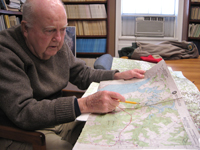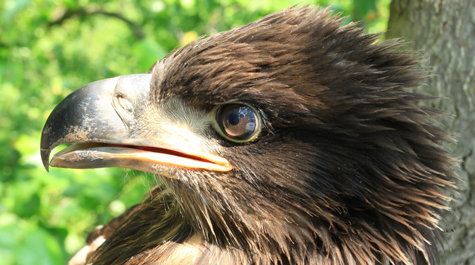Mitchell Byrd takes the co-pilot seat for his 38th year of bald eagle census flights
The Center for Conservation Biology has begun its 2014 flights to survey nesting bald eagles and Mitchell Byrd is once again in the co-pilot seat.
Byrd, Professor of Biology Emeritus at William & Mary, has begun his 38th year of participation in the annual flights designed to record the region’s breeding stock of bald eagles. He anchors a three-man team that includes Center for Conservation Biology Director Bryan Watts and a former fighter pilot named Shermer who goes by the name of Captain Fuzzzo. “Spelled with three ‘z’s,” he says. “The middle z is silent.”
 The eagles started coming back in the 1970s, after the banning of the toxic pesticide DDT. Byrd began doing the flights in 1977, when there were 30-some bald eagle nests scattered throughout Tidewater Virginia. The Byrd-Watts-Shermer team has worked together for 23 years and have witnessed first-hand the resurgence of the bald eagle population along the shores of the Chesapeake and its tributaries. In 2013, the CCB team logged 200 nests along the James River alone.
The eagles started coming back in the 1970s, after the banning of the toxic pesticide DDT. Byrd began doing the flights in 1977, when there were 30-some bald eagle nests scattered throughout Tidewater Virginia. The Byrd-Watts-Shermer team has worked together for 23 years and have witnessed first-hand the resurgence of the bald eagle population along the shores of the Chesapeake and its tributaries. In 2013, the CCB team logged 200 nests along the James River alone.
The region’s eagle population has grown to the point that it keeps all three of them busy. Watts sits in the back seat of the Cessna, spotting the nests and calling them out to Byrd, who sits in the co-pilot seat, marking the locations on a set of topographic maps. Captain Fuzzzo flies the plane, at altitudes low enough that Byrd can see not only the nests, but the birds, chicks and eggs in them.
“There are a lot of good pilots out there,” Byrd said, “but one of the reasons we like working with Fuzzzo is that he doesn’t mind flying low.”
The increase in population has created ramifications beyond the fact that the CCB has more eagle nests to count, especially along the James River. The James is southernmost of the Chesapeake’s major tributaries and has become prime real estate for nesting bald eagles. In his 38 years of eagle census flights, Byrd has recorded the expansion of the James River breeding population from zero to something near saturation. The abundance of nesting eagles along the James has allowed the CCB to study the dynamics of a population of our national bird at breeding season, revealing interesting, and sometimes puzzling, new aspects of bald eagle behavior that haven’t been studied before, even by the scientists working eagle-rich Alaska.
“Alaska has a lot of eagles, but they also have a whole lot more territory,” Byrd said, explaining that the breeding density along the James make it an ideal place to study the sociology of bald eagles.
The team has logged not only instances of competition for prime nest trees, but also examples of eagle “threesomes,” “home invasions,” “deadbeat dads” and “cheating wives.”
The trio ran their first flight of 2014 on March 5, an eight-hour stint of logging nesting eagles along the James River. Watts says that the James typically has the earliest breeders in the survey, with an average breeding date of Feb. 6, but one pair of early birds nesting on Jamestown Island in the 1980s had historically been so far ahead that they were dubbed the “Christmas Eagles.”
The March 5 flight showed birds that were even earlier breeders than the Christmas Eagles, including several nests with young old enough to indicate that the eggs were laid in December. Watts said that one two-chick brood was eight weeks old, another single-chick brood was seven weeks old, while a third two-chick brood was six weeks old.
“The clutch for the eight-week-old brood would have been laid in late November, a time when most pairs had not even initiated courtship or nest repair,” Watts said. “They were feeding young before almost all other pairs had begun to lay eggs.”
He noted that the early-breeding eagles are clustered in a short stretch of the James, between Jamestown and Smithfield, and he says he can’t yet explain why this short stretch of shoreline produces the early breeders. Watts said that the early birds pose other questions, including how, and if, the early breeding is related to the population expansion, as well as the practical matter of the prey the early birds are exploiting to bring off a set of chicks before the rest of the region’s eagles have even begun nesting.
The 2014 round census flights will continue, to be followed later in the spring by a second round, known as “productivity flights,” in which the team will check for eagle chicks. Mitchell Byrd will be aboard Fuzzzo’s Cessna for all the flights and he says has no intention of relinquishing his co-pilot’s seat, this year or any year.
“I guess I’ll be doing this as long as Bryan will let me,” he said. “I enjoy it. I may be 85 years old, but I feel like I’m 45. So why not go on?”
The Center for Conservation Biology is a program operated jointly by William & Mary and Virginia Commonwealth University.
















